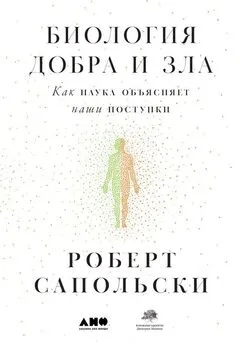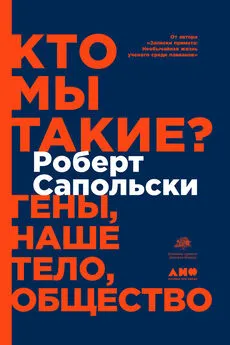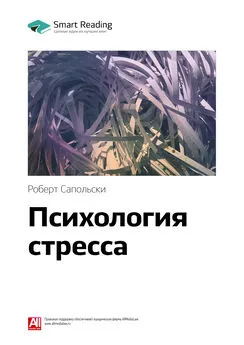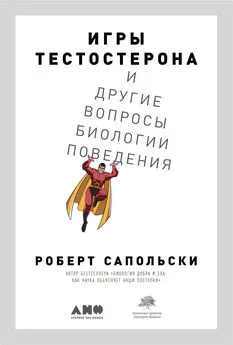Роберт Сапольски - Биология добра и зла. Как наука объясняет наши поступки
- Название:Биология добра и зла. Как наука объясняет наши поступки
- Автор:
- Жанр:
- Издательство:Альпина нон-фикшн
- Год:2019
- Город:Москва
- ISBN:978-5-0013-9051-0
- Рейтинг:
- Избранное:Добавить в избранное
-
Отзывы:
-
Ваша оценка:
Роберт Сапольски - Биология добра и зла. Как наука объясняет наши поступки краткое содержание
Биология добра и зла. Как наука объясняет наши поступки - читать онлайн бесплатно ознакомительный отрывок
Интервал:
Закладка:
231
К сноске: ДГЭА и местный синтез стероидов в нейронах: K. Soma et al., “Novel Mechanisms for Neuroendocrine Regulation of Aggression,” Front Neuroendocrinology 29 (2008): 476; K. Schmidt et al., “Neurosteroids, Immunosteroids, and the Balkanization of Endo,” General and Comp Endo 157 (2008): 266; D. Pradhan et al., “Aggressive Interactions Rapidly Increase Androgen Synthesis in the Brain During the Non-breeding Season,” Horm Behav 57 (2010): 381.
232
T. Johnson, “Premenstrual Syndrome as a Western Culture-Specific Disorder,” Culture, Med and Psychiatry 11 (1987): 337; L. Cosgrove and B. Riddle, “Constructions of Femininity and Experiences of Menstrual Distress,” Women & Health 38 (2003): 37.
233
Цитата в тексте см.: M. Rodin, “The Social Construction of Premenstrual Syndrome,” Soc Sci & Med 35 (1992); 49. Цитата в сноске взята из: A. Kleinman, “Depression, Somaticization, and the New ‘Cross-Cultural Psychiatry,’” Social Science Med 11 (1977): 3.
234
H. Rupp et al., “Neural Activation in the Orbitofrontal Cortex in Response to Male Faces Increases During Follicular Phase,” Horm Behav 56 (2009): 66. Mareckova K. et al. “Hormonal Contraceptives, Menstrual Cycle and Brain Response to Faces. SCAN 9 (2012): 191.
235
A. Rapkin et al., “Menstrual Cycle and Social Behavior in Vervet Monkeys,” PNE 20 (1995): 289; E. García-Castells et al., “Changes in Social Dynamics Associated to the Menstrual Cycle in the Vervet Monkey ( Cercopithecus aethiops ),” Boletín de Estudios Médicos y Biológicos 37 (1989): 11; G. Mallow, “The Relationship Between Aggressive Behavior and Menstrual Cycle Stage in Female Rhesus Monkeys ( Macaca mulatta ),” Horm Behav 15 (1981): 259; G. Hausfater and B. Skoblic, “Perimenstrual Behavior Changes Among Female Yellow Baboons: Some Similarities to Premenstrual Syndrome (PMS) in Women,” Animal Behav 9 (1985): 165.
236
K. Dalton, “School Girls’ Behavior and Menstruation,” Brit Med J 2 (1960): 1647; K. Dalton, “Menstruation and Crime,” Brit Med J 2 (1961): 1752; K. Dalton, “Cyclical Criminal Acts in Premenstrual Syndrome,” Lancet 2 (1980): 1070.
237
P. Easteal, “Women and Crime: Premenstrual Issues,” Trends and Issues in Crime and Criminal Justice 31 (1991): 1–8; J. Chrisler and P. Caplan, “The Strange Case of Dr. Jekyll and Ms. Hyde: How PMS Became a Cultural Phenomenon and a Psychiatric Disorder,” Ann Rev of Sex Res 13 (2002): 274.
238
Обзорный анализ см. в: R. Sapolsky, Why Zebras Don’t Get Ulcers: A Guide to Stress, Stress-Related Diseases and Coping , 3rd ed. (New York: Henry Holt, 2004).
239
R. Sapolsky “Stress and the Brain: Individual Variability and the Inverted-U,” Nat Nsci 25 (2015): 1344.
240
K. Roelofs et al., “The Effects of Social Stress and Cortisol Responses on the Preconscious Selective Attention to Social Threat,” BP 75 (2007): 1; K. Tully et al., “Norepinephrine Enables the Induction of Associative Long-Term Potentiation at Thalamo-Amygdala Synapses,” PNAS 104 (2007): 14146; P. Putman et al., “Cortisol Administration Acutely Reduces Threat-Selective Spatial Attention in Healthy Young Men,” Physiology & Behav 99 (2010): 294; K. Bertsch et al., “Exogenous Cortisol Facilitates Responses to Social Threat Under High Provocation,” Horm Behav 59 (2011): 428.
241
J. Rosenkranz et al., “Chronic Stress Causes Amygdala Hyperexcitability in Rodents,” BP 67 (2010): 1128; S. Duvarci and D. Pare, “Glucocorticoids Enhance the Excitability of Principle Basolateral Amygdala Neurons,” J Nsci 27 (2007): 4482; A. Kavushansky and G. Richter-Levin, “Effects of Stress and Corticosterone on Activity and Plasticity in the Amygdala,” J Nsci Res 84 (2006): 1580; A. Kavushansky et al., “Activity and Plasticity in the CA1, the Dentate Gyrus, and the Amygdala Following Controllable Versus Uncontrollable Water Stress,” Hippocampus 16 (2006): 35; P. Rodríguez Manzanares et al., “Previous Stress Facilitates Fear Memory, Attenuates GABAergic Inhibition, and Increases Synaptic Plasticity in the Rat Basolateral Amygdala,” J Nsci 25 (2005): 8725; H. Lakshminarasimhan and S. Chattarji, “Stress Leads to Contrasting Effects on the Levels of Brain Derived Neurotrophic Factor in the Hippocampus and Amygdala,” PLoS ONE 7 (2012): e30481; S. Ghosh et al., “Functional Connectivity from the Amygdala to the Hippocampus Grows Stronger After Stress,” J Nsci 33 (2013): 7234.
242
B. Kolber et al., “Central Amygdala Glucocorticoid Receptor Action Promotes Fear-Associated CRH Activation and Conditioning,” PNAS 105 (2008): 12004; S. Rodrigues et al., “The Influence of Stress Hormones on Fear Circuitry,” Ann Rev Nsci 32 (2009): 289; L. Shin and I. Liberzon, “The Neurocircuitry of Fear, Stress, and Anxiety Disorders,” Neuropsychopharmacology 35, no. 1 (January 2010): 169.
243
M. Milad and G. Quirk, “Neurons in Medial Prefrontal Cortex Signal Memory for Fear Extinction,” Nat 420 (2002): 70; E. Phelps et al., “Extinction Learning in Humans: Role of the Amygdala and vmPFC,” Neuron 43 (2004): 897; J. Bremner et al., “Neural Correlates of Exposure to Traumatic Pictures and Sound in Vietnam Combat Veterans With and Without Posttraumatic Stress Disorder: A Positron Emission Tomography Study,” BP 45 (1999) 806; D. Knox et al., “Single Prolonged Stress Disrupts Retention of Extinguished Fear in Rats,” Learning & Memory 19 (2012): 43; M. Schmidt et al., “Stress-Induced Metaplasticity: From Synapses to Behavior,” Nsci 250 (2013): 112; J. Pruessner et al., “Deactivation of the Limbic System During Acute Psychosocial Stress: Evidence from Positron Emission Tomography and Functional Magnetic Resonance Imaging Studies,” BP 63 (2008): 234.
244
A. Young et al., “The Effects of Chronic Administration of Hydrocortisone on Cognitive Function in Normal Male Volunteers,” Psychopharmacology (Berlin) 145 (1999): 260; A. Barsegyan et al., “Glucocorticoids in the Prefrontal Cortex Enhance Memory Consolidation and Impair Working Memory by a Common Neural Mechanism,” PNAS 107 (2010): 16655; A. Arnsten et al., “Neuromodulation of Thought: Flexibilities and Vulnerabilities in Prefrontal Cortical Network Synapses,” Neuron 76 (2012): 223; B. Roozendaal et al., “The Basolateral Amygdala Interacts with the Medial Prefrontal Cortex in Regulating Glucocorticoid Effects on Working Memory Impairment,” J Nsci 24 (2004): 1385; C. Liston et al., “Psychosocial Stress Reversibly Disrupts Prefrontal Processing and Attentional Control,” PNAS 106 (2008): 912.
245
E. Dias-Ferreira et al., “Chronic Stress Causes Frontostriatal Reorganization and Affects Decision-Making,” Sci 325 (2009): 621; D. Lyons et al., “Stress-Level Cortisol Treatment Impairs Inhibitory Control of Behavior in Monkeys,” J Nsci 20 (2000): 7816; J. Kim et al., “Amygdala Is Critical for Stress-Induced Modulation of Hippocampal Long-Term Potentiation and Learning,” J Nsci 21 (2001): 5222; L. Schwabe and O. Wolf, “Stress Prompts Habit Behavior in Humans,” J Nsci 29 (2009): 7191; L. Schwabe and O. Wolf, “Socially Evaluated Cold Pressor Stress After Instrumental Learning Favors Habits over Goal-Directed Action,” PNE 35 (2010): 977; L. Schwabe and O. Wolf, “Stress-Induced Modulation of Instrumental Behavior: From Goal-Directed to Habitual Control of Action,” BBR 219 (2011): 321; L. Schwabe and O. Wolf, “Stress Modulates the Engagement of Multiple Memory Systems in Classification Learning,” J Nsci 32 (2012): 11042; L. Schwabe et al., “Simultaneous Glucocorticoid and Noradrenergic Activity Disrupts the Neural Basis of Goal-Directed Action in the Human Brain,” J Nsci 32 (2012): 10146.
246
V. Venkatraman et al., “Sleep Deprivation Biases the Neural Mechanisms Underlying Economic Preferences,” J Nsci 31 (2011): 3712; M. Brand et al., “Decision-Making Deficits of Korsakoff Patients in a New Gambling Task with Explicit Rules: Associations with Executive Functions,” Neuropsychology 19 (2005): 267; E. Masicampo and R. Baumeister, “Toward a Physiology of Dual-Process Reasoning and Judgment: Lemonade, Willpower, and Expensive Rule-Based Analysis,” Psych Sci 19 (2008): 255.
247
S. Preston et al., “Effects of Anticipatory Stress on Decision-Making in a Gambling Task,” Behav Nsci 121 (2007): 257; R. van den Bos et al., “Stress and Decision-Making in Humans: Performance Is Related to Cortisol Reactivity, Albeit Differently in Men and Women,” PNE 34 (2009): 1449; N. Lighthall et al., “Acute Stress Increases Sex Differences in Risk Seeking in the Balloon Analogue Risk Task,” PLoS ONE 4 (2009): e6002; N. Lighthall et al., “Gender Differences in Reward-Related Decision Processing Under Stress,” SCAN 7, no. 4 (April 2012): 476–84; P. Putman et al., “Exogenous Cortisol Acutely Influences Motivated Decision Making in Healthy Young Men,” Psychopharmacology 208 (2010): 257; P. Putman et al., “Cortisol Administration Acutely Reduces Threat-Selective Spatial Attention in Healthy Young Men,” Physiology & Behav 99 (2010): 294; K. Starcke et al., “Anticipatory Stress Influences Decision Making Under Explicit Risk Conditions,” Behav Nsci 122 (2008): 1352.
248
E. Mikics et al., “Genomic and Non-genomic Effects of Glucocorticoids on Aggressive Behavior in Male Rats,” PNE 29 (2004): 618; D. Hayden-Hixson and C. Ferris, “Steroid-Specific Regulation of Agonistic Responding in the Anterior Hypothalamus of Male Hamsters,” Physiology & Behav 50 (1991): 793; A. Poole and P. Brain, “Effects of Adrenalectomy and Treatments with ACTH and Glucocorticoids on Isolation-Induced Aggressive Behavior in Male Albino Mice,” Prog Brain Res 41 (1974): 465; E. Mikics et al., “The Effect of Glucocorticoids on Aggressiveness in Established Colonies of Rats,” PNE 32 (2007): 160; R. Böhnke et al., “Exogenous Cortisol Enhances Aggressive Behavior in Females, but Not in Males,” PNE 35 (2010): 1034; K. Bertsch et al., “Exogenous Cortisol Facilitates Responses to Social Threat Under High Provocation,” Horm Behav 59 (2011): 428.
249
S. Levine et al., “The PNE of Stress: A Psychobiological Perspective,” in Psychoneuroendocrinology , ed. S. Levine and R. Brush (New York: Academic Press, 1988), p. 181; R. Sapolsky and J. Ray, “Styles of Dominance and Their Physiological Correlates Among Wild Baboons,” Am J Primat l8 (1989): l; J. C. Ray and R. Sapolsky, “Styles of Male Social Behavior and Their Endocrine Correlates Among High-Ranking Baboons,” Am J Primat 28 (1992): 231; C. E. Virgin and R. Sapolsky, “Styles of Male Social Behavior and Their Endocrine Correlates Among Low-Ranking Baboons,” Am J Primat 42 (1997): 25.
Читать дальшеИнтервал:
Закладка:





![Роберт Сапольски - Игры тестостерона и другие вопросы биологии поведения [litres]](/books/1074102/robert-sapolski-igry-testosterona-i-drugie-vopros.webp)




